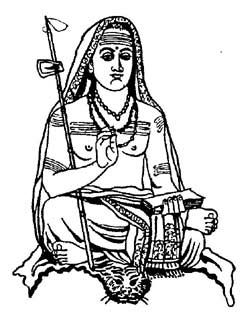 |
Sri Shankara Bhagavatpada And Sri Kanchi Kamakoti Shankaracharya Math Moolamnaya Sarvajna Peetham |
ContentsKancheepuramSri Sankara Bhagavatpadacharya Initiation into regular Sanyasa Sankara at Kasi Sankaras' Kailasa Yatra Kailas to Kanchi Sri Shankaracharya's Sarvajnapeetharohana at Kanchi Kanchi -Shankaracharya's Last Resort Monastic Institutions (Mathas) established by Sri Shankaracharya Appendix I Appendix II - History of Acharaparampara
|

Sculpture of Sri Sankara in Dandavandanam pose before Siva and Parvati in the Sanctum Sanctorum of the Sivasthanam at Thenambakkam, Kanchipuram |
Kancheepuram
Kancheepuram is a celebrated place of pilgrimage. It is popularly known as Kanchi. Kancheepuram is situated about 74 kilometers southwest of Chennai by road. Kancheepuram has a railway station, which stands midway between Chengalpattu and Arakkonam Junctions.
Kanchi is one of the seven Mokshapuris -sacred cities by living in which or by death therein man gets emancipation from birth and death. It is the only Mokshapuri in South India.
Five important sacred places of Siva worship in South India are collectively called "Panchabhuta- Kshetras". Of these five, Kanchi is the Prithvi-kshetra.
Kamakshi Vilasam, a section of the Markandeya Purana points to Kanchi as the "Nabhisthanam" -navel of the Universe. (Vide Chapters X and XI).
Kanchi has been a center of literary pursuits and advanced learning. Inscriptions at Kanchi point to the existence of Ghatikastan during Pallava regime. Sri Kanchi Kamakoti Peetham has established a Deemed University - Sri Chandrasekharendra Saraswati Viswa Mahavidyalaya at Kancheepuram with an International Library. Various disciplines are taught at the University.
Kancheepuram is a city of temples: Some of the most important temples in Kancheepuram are for Sri Kamakshi Ambal, Sri Ekambaranatha, Sri Varadaraja, Sri Kailasanathar, Sri Vaikunta Perumal, Ulakalantha Perumal, etc.
Sri Adi Sankara, after his various tours through most parts of India, settled down at Kanchi to spend His evening years. He caused to remodel the city and reconstruct the three principal temples -Sri Kamakshi, Sri Ekamranatha and Sri Varadaraja. At Kanchi, he established a Math for himself and founded a line of successors after him on the Peetha. At present, the presiding Shankaracharya is Pujyashri Sankara Vijayendra Saraswati Swamigal, the 70th Shankaracharya. On 30th April 2025, His Holiness gave Sanyasa to Pujya Satya Chandrasekharendra Saraswathi Swamigal, the 71st Acharya.
Sri Sankara Bhagavatpadacharya
In this mundane world, conflict between good and evil has been a legendary phenomenon from time out of mind. When this conflict turns acute and causes a crisis in the basic culture of the land, divine force intervenes to set things right. We find a number of anecdotes about demons endowed with tremendous might, causing harm of non-mean degree, not only to human beings but to the celestials as well. The Puranas speak of the avataras (incarnations) of Lord Vishnu who destroyed the demons and established the path of righteousness - Dharma. More than 2500 years ago, an avalanche of heretic and non-Vedic sects, with horrible religious practices threatened to wipe away the ancient Veda-Dharma. In the Bhagavad Geeta, Lord Krishna has told Arjuna that, whenever there arises danger to Dharma, He (Krishna) will incarnate in this world to eradicate adharma and re-establish Dharma. In consonance with His words, the Lord has made partial incarnations during the course of the present Kali Age. And such an incarnation is the partial incarnation of Siva as Sankara Bhagavatpada, which happened some twenty-five centuries ago, on the prayer of celestials to Lord Siva to redeem Bharata-desa from the clutches of non-Vedic and heretic sects.
Sri Sankara Bhagavadpadacharya was one of the greatest philosophers and spiritualists of, the world. He was a discerning dialectician, a consummate commentator and a celebrated poet. His miraculous achievements, within a short span of life of thirty-two years, speak of his super-human aspect. Sages and scholars, who have shone through the centuries after his time, have regarded him as an incarnation of the Divine. Many a thinker and many a scholar of different climes and times has been attracted by the philosophic discipline of Advaita (Monism), effectively propagated by Sankara. Even modern thinkers and scholars of repute have paid eulogistic tributes to Sankara's genius.
There lived a pious Brahmin couple -Sivaguru and Aryamba -in the village of Kaladi in Kerala. Even after years after their marriage they had no issue. So they went to Tiruchivaperur (modern Trichur in Kerala) and stayed there for a number of days and worshipped Vrshachalesvara, the presiding deity of the temple there, praying for a male offspring. Sankara biographies narrate that both Sivaguru and his wife had identical dreams, at night of the last day of their stay in Tiruchivaperur, in which the Lord asked them if they desired to have a single son endowed with good qualities, wisdom and intelligence or sons wicked and idiotic by nature and that the couple left the decision of the choice to the Lord Himself.
Months after Sivaguru and Aryambal had returned to Kaladi, a male child was born to Aryambal, on the fifth day of the bright fortnight of the Vaisaka month of the cyclic year Nandana (509 B.C.). Though many dates are assigned for the birth of Sankara, this date may be said to be fairly well established by research scholars on the basis of literary, architectural and astrological sources of information. The parents gave the name "Sankara" to the child. The life story of Sankara is told in many purely biographical works and also short sketches of the Great Acharya are had in works devoted to other topics. But since all works, which narrate the history of Sankara, have been produced, many centuries after his lifetime, the historian of Sankara has to depend on the lot of traditional information that has gathered round Sankara's name and fame.
Sri Jadunath Sircar, an eminent indian historian, Member of the Royal Asiatic Society of Great Britain, in his "History of Naga Sanyasins", published by Sri Panchayati, Akhara Mahanirvani, Dharagunj, Allahabad says: "The modern historian of Sankara is left only with the legend of Sankara as developed by pious tradition and he must try to judge the narratives in the weight of probability and the known facts about India in the age of Sankara".
Sri B. Suryanarayana Row, M.R.A.S., founder-editor of the Astrological Magazine, Bangalore, in his 'History of the Never to be Forgotten Empire of Vijayanagar', has written (in the preface): "Tradition, when strongly supported by internal and external evidence in literature and inscriptions, ought not to be neglected or rejected, simply because, in the light of present knowledge, certain events appear incredible. The true spirit of profound enquiry must be the guide to Indian history."
Swami Tapasyananda of Sri Ramakrishna Math, in the introduction to his English translation of Maadhaveeya Sankara-Vijaya, observes "We have today only a lot of traditions about Shankaracharya and he is a foolhardy man, indeed, who dares to swear by anyone of these traditions as truly historical and the others as fabricated."
Sri Vidyanand Saraswati, in his forward to the English translation of the "Age of Shankar" of Udayavir Sastri, observes, "It is really unfortunate that Indians had to learn their own history from foreign scholars. These scholars with insufficient data and superficial knowledge of our tradition wrote textbooks on Indian history, which were mainly responsible for a great deal of erroneous views about our past. To understand, to recapture and to live up to the best of our traditions, it is necessary for a scholar to discover for himself the truth enveloped in obscurity made hazy in the name of research."
Having had his upanayanam at the age of five, Sankara was sent to a local patasala for studying the Veda. One forenoon, during his rounds for collecting biksha (alms), Sankara happened to stop in front of a poor man's house and uttered the usual word of request for biksha -"Bhavati bikkshamdehi". The lady of the house came out and saw the lustrous little brahmachari. She went in and searched for something for offering to the boy. But there was nothing in the house to offer. She picked up a dry amla fruit and dropped it in Sankara's bowl. The boy looked at the woman and noticed the lines of poverty and sorrow writ large on her face. He began singing the praise of Sri Mahalakshmi, the Goddess of Wealth, in fine Sanskrit verses. And lo! Mahalakshmi stood above the house. Sankara requested the Goddess to provide the means for the livelihood of the inmates of that house. The Devi caused a shower of gold amalakas on that house. The eighteen verses of Sankara's prayer to Lakshmi go by the name "Kanakadhara Stotram". This very first poem of Sankara breathes with his compassion and concern for the poor and the needy. At the age of eight Sankara finished the study of the Veda. The idea of becoming an ascetic was revolving in his mind. One morning when he was bathing in the river flowing by the side of his house, a crocodile caught one of his feet and began to drag him into the deep. Sankara shouted for help. His mother came running to the bank of the river. Sankara told his weeping mother, "In accordance with my doings during past births I have to die. But I may continue to live if I become an ascetic, since change of asrama causes a new birth. Hence grant me permission to become a sanyasi quickly". Aryamba reluctantly agreed, as she desired to have her son alive at least as an ascetic. Sankara took to apat-sanyasa (becoming an ascetic in time of danger) by uttering the pertinent mantras. Suddenly the crocodile left Sankara's foot, turned into a gandharva (good spirit) and flew up after praising Sankara.
Aryamba asked Sankara to come home. Sankara told her that from that day, the wide world was his home and whoever offered him alms was his mother. Aryamba asked him as to who would perform her funeral rites if she died in his absence. Sankara consoled his sobbing mother saying that he would be by her side whenever she chose to think of him and that he would perform the due rites on her death.
Initiation into regular Sanyasa
Leaving his old mother in the care of near relatives, Sankara left Kaladi and began to travel towards the north, in search of a preceptor to get himself initiated into regular sanyasa. Months later he reached the bank of the Narmada. He learnt from the people living nearby that a great yogi lived in a cave near the riverbank and that he was spending most of his time in penance. Soon Sankara went near that cave and stood before the entrance to the cave singing about the yogin in some couplets. The yogi, Sri Govinda Bhagavatpada, recipient of the Mahabhashya from the lips of Sri Gaudapada, asked from within the cave, who was standing near the cave. The reply of Sankara was in the form of 10 slokas ending with the refrain "Sivahkevaloham", These ten slokas constitute the famous Dasasloki of the Acharya. Immensely pleased, Govindamuni came out of the cave. Sankara who was struck by the divine personality of Govinda Bhagavatpada fell at his feet. After some conversation, Govinda Bhagavatpada accepted Sankara as his disciple and initiated him in all the Mahavakyas, Some of the biographies say that Sankara lived on with his 'guru' for about 3 years and learnt the spiritual truths and the disciplines under Govinda Bhagavatpada. After mastering all that had to be learnt from the 'guru', Sankara was granted permission to leave, and the guru told him, that Sankara should preach Advaita Vidya, and also write an authoritative commentary on the Brahma Sutras. He instructed Sankara to go to Benaras, which was the spiritual centre of gravity of India, to do this work. Accordingly in course of time, Sankara returned to Kasi, crossing the Vindhya Mountains, after a prolonged journey of months.
Sankara at Kasi
Taking leave of his preceptor, Sankara left the Narmada bank and in course of time reached Kasi, also known as Varanasi, situated on the bank of the sacred Ganga, as desired by his preceptor. Sankara's stay at Kasi was for about four years. During this period, a number of disciples gathered around him to learn the Advaita Vedanta. A prominent one of them was Sanadana, a native of the Chola country. It was during these years that Sankara wrote the famous commentaries on Vyasa's Brahmasutras, the principle Upanishads and the Bhagavad-Geeta. Besides the bashyas on Vishnusahasranama and the Lalita Trisatistotra are also said to have been written by him during his long stay at Kasi. One day, when Sankara was seated at the Manikarnika Ghat in Varanaasi, Sage Vyasa came here, disguised as an old Brahmin. He saw a young ascetic sitting amidst numerous disciples and looking like Siva with his attendants, as Indra in the middle of celestials and as Brahma surrounded by sages. Vyasa asked the disciples who the boy ascetic was. They replied "Oh! Old man! This is Sankara, the preceptor steeped in bliss. Having dissolved heretic sects in many places, having produced a commentary, with clear and decisive interpretations on the Brahmasutras, and having taught Advaita philosophy to discerning students, he shines as Rudra on the bank of the Ganga." Then Vyasa got near the group of disciples and sat before Sankara. A long and heated debate ensued between the two on the purport of some of Vyasa's Brahmasutras. At a particular stage, Sankara learnt from a hint of his disciple, Padmapada, that the old man was Sage Vyasa in disguise and bowed before him. Immensely satisfied with Sankara's exposition of the Brahmasturas, Vyasa blessed Sankara and departed along with Brahma who had gone over there to grant an extension of life to Sankara.
During the long stay at Kasi, one morning Sankara was returning with his disciples from the temple of Visvesvara. An outcaste, leading four dogs, stood on the way. Sankara asked him to clear away from the path. But the outcaste did not move and asked Sankara, "From which, do you want and, what, to go where? Do you want this body, which has been similarly built out of food? Do you want one living consciousness to go away from another? What do you say, Oh! Learned Brahmin? Which do you want to differentiate; this body of matter or the living Chaitanya?"
Sankara was struck dumb at this, as the very purpose of all his teachings, that the Self alone is the sole Reality, had been summarised by the Chandala in a single verse. Sankara immediately understood the Vedantic purport of the Chandala's question and also conjectured that the Lord Himself had come in the form of a Chandala to test if Sankara had realised the truth that he had been teaching. He then uttered in reply, those immortal slokas which go by the name of "Manishapanchaka". These represent the high watermark of Sankara's teaching, where the consistency of a remorseless dialectician, Sankara declares, that he, who has realised the oneness of the Brahman, and he who has intuited the Truth of this doctrine, is fit to be even Sankara's master, even though he, be a Chandala or a high caste Brahmin by birth. Even as he was about to conclude the small poem, the outcaste and his dogs disappeared and Lord Visvanatha was seen above the place, blessing the Acharya. When Sankara left Kasi, the King of Kasi, scholars and people bowed before him and bid him farewell.
Biographies narrating in full the story of Sankara speak extensively regarding the long tours of Sankara to many parts of the country. These digvijaya travels may be said to have begun from the time of Sankara's leaving the sacred city of Kasi. Biographies of Sankara tell about Sankara's visit to Prayag, Badrinath, Kashmir and to a number of places in the south such as Chidambaram, Madhyarjunam, Jambukesvaram, Srirangam, Rameswaram, Tirupati and to many other sacred spots lIke like Dwaraka in the west coast and Puri Jagannath on the eastern coast.
Sankaras' Kailasa Yatra
Sankara's yatra to Kajlasa, the abode of Lord Siva, is one of the most notable events in the history of the Acharya. During the course of his peregrination in the Himalayan region, Shankaracharya desired to have darshan of Sri Paramesvara having his abode in Kailas. Sankara managed to reach Kailas quickly because of his yogic power. He had darshan of Lord Paramesvara and Devi Parvati. According to tradition, Sankara adored Paramesvara by singing two hymns, known as "Sivapadadi-kesanta stotram" and "Sivakesadipadanta stotram", Immensely pleased with Sankara's prayers, Paramesvara blessed Sankara, presented him with five sphatika (crystal) lingas and instructed him to arrange for the worship of the Ifngas Iingas for the sake of the welfare of the universe, indicating also the mode of worship. Paramesvara also handed over to Sankara the palm-leaf manuscript of Soundarya Lahari, which is noted as Siva's own hymn in praise of the Parasakti.
Kailas to Kanchi
From available biographical information, it is learnt that Shankaracharya placed one of the five sphatika lingas got at Kailas, the Mukti Linga in the temple at Kedarnath, and that he consecrated the Vara Linga at Neelakanta Kshetra in Nepal. With the other three, he returned to the south. He placed the Bhoga Linga for being worshipped at the Sarada Peetha in Karnataka and he sent the Moksha Linga to Chidambaram for being worshipped In the temple of Sri Nataraja in that sacred place, He kept the Yoga Linga for his own personal worship and for his successors at Kanchi.
References to the places where the five-sphatika lingas were established for worship are found in Anantanandagiri's biography and in Markandeya Samhita. The Sivarahasya points to Sankara's hastening to the earth with the lingas and worshipping them in his own asrama at Kanchi. The people of Kanchi, under the leadership of King Rajasena, offered a grand welcome to Sankara at the outskirts of Kanchi City, It is said that the Acharya stayed at the Mukti Mandapa in the small Visvesvara temple, on the bank of the Sarvateertham tank for some time.
Bhagavatpada Sankara got Kanchi city remodeled and also caused the reconstruction of the three principle temples of Kanchi viz., the temples of Sri Ekamranatha, Devi Kamakshi and Sri Varadaraja with the assistance of Rajasena, ruler of Kanchi. Sankara consecrated the Srichakra before Devi Kamakshi and thereby secured Her bounteous grace on devotees having Her darshan.
Sri Shankaracharya's Sarvajnapeetharohana at Kanchi
A significant event in the history of Shankaracharya is his occupying the Sarvajna Peetha -the Throne of Omniscience at Kanchi. Cidvilasa's Sankaravijaya -Vilasa, Govindanantha's Shankaracharya Charitam and Rajachudamani Dikshita's Sankarabhudaya, narrate the Acharya's ascending the seat of Omniscience at Kanchi, in South India.
Sixteen verses of the 25th chapter of Cidvilasa's biography describe the event. An asareeri voice (air noise or divine voice) informed Sankara, when he was about to ascend the Peetha, that it would be proper for him to ascend after winning in debate, the scholars assembled there. Sankara thought for a while. A group of scholars who had come there from some villages of the Tamraparni valley put some questions to Shankaracharya on his philosophy of Monism, Maya (the theory of illusion), Devabeda, Murtibeda, etc. Sankara explained to them the eternal and all-pervading nature of Brahman, the inability of man to understand the Supreme One seeming as different entities, because of ignorance, the non-existence of a second other than the Brahman and the means for attaining emancipation. The scholars were fully convinced. They bowed before the Great Acharya. Thereafter Sankara ascended the Sarvajnapeetha amidst the sounding of musical instruments and the tumultuous shouts of joy of the vast number of devoted spectators. Showers of flowers fell from above and a fragrant breeze blew all around.
A great ascetic one of the early Acharyas of the Kanchi Shankaracharya Math -by name Jnanottama -has written a commentary entitled "Chandrika", on Sureswaracharya's "Naiskarmyasiddhi". Along with the commentary "Chandrika", Naishkarmyasiddhi has been edited by Professor Hiriyanna of the Maharaja's College, Mysore and published as No.33 of the Bombay Sanskrit and Prakrit Series in 1925 C.E. In the preface to this edition Professor Hiriyanna observes "The second sloka (at the end of the commentary) alludes to the author of the Chandrika as the glory of the Sarvajnasrama by which term we have to understand the Sarvajna Peetha or the Pontifical seat at the Advaita Matha In Kanchipuram. These remarks of the learned professor corroborate Sankara's occupying the Sarvajna Peetha at Kanchi, as described in the biographies noted above.
Kanchi -Shankaracharya's Last Resort
Sankara Bhagavatpadacharya returned to Kanchi, the Southern Mokshapuri, towards the end of his earthly career and shook off his moral coils in that sacred city. A number of works state these facts.
Verse 46 of the sixteenth chapter of the ninth section of the voluminous Sanskrit work "Sivarahasya" (in the printed Canareese edition No.32, Jayachamarajendra Series of the Mysore Palace, refers to Shankaracharya's worship of the Yoga, Bhoga, Vara, Mukti and Moksha lingas, to his success over scholars of other faiths and to his attaining siddhi (eternal bliss) at his own ashrama in Kanchi.
Markandeya Samhita, an ancient puranic treatise, consists of 100 khandas, each having sub-sections called parispandas, Sub-section 7 and 8 of the 72nd khanda of this work narrate briefly the history of Sankara. This is evident from the colophon at the end of the 7th parispanda of the 72nd khanda as noticed in the Descriptive Catalogue of Sanskrit Manuscripts, volume VI of the Oriental Research Institute, University of Mysore, 1981, page 191 (Appendix 1- 332, Serial No.18179, Ms. No. P. 33878/1 -title "Sankaracharitam". A verse, in the seventh parispanda of the 72nd khanda 01 this work, relates that the Mahatma, Sankara, attained the cit-svarupa, He attained eternal bliss at Kanchi, after having consecrated Kamakshi.
Anantanandagiri's biography of Sankara (all versions printed and manuscripts, including the Madras University edition) says "The World Preceptor (Sankara) desiring to leave for his own abode, sitting once in the Moskhapuri of Kanchi, absorbed his gross body into the subtle one and getting reduced into the size of a thumb, attained eternal bliss and remains at the all-pervading "Cit" to this day". The Brhad Sankara Vijaya, and Sri Sadasiva Brahmendra's Gurunatramala indicate that Acharya Sankara attained eternal bliss at Kanchi -the Southern Mokshapuri. The concluding verse of Rajacudamani Deeksita's "Sankarabhyudaya" refers to Sankara worshipping Kamesvari (Kamakshi) every day and attaining supreme bliss. Patanjali Vijayam by Ramabhadra Diksita (Kavyamala Series No.51 , Nirnaya Sagar Press, Bombay), has a verse at the end, stating that Sankara, after having produced the Bhasyas and conquered the directions (digvijaya) stayed permanently at Kanchi.
A Report on Search for Sanskrit Manuscripts in South India, by Dr. Hutzch, a German scholar, (published by the Government Press, Madras in 1905 -No.2146, Part III) contains a list of pontifical preceptors of the Bharati ascetic order of the Tungabhadra region. Some verses are found in this list about Adi Shankaracharya. The verses relate that after traveling widely Sankara reached Kanchi of his own accord, consecrated Kamakshi and attained final beatitude at Kanchi itself. The Guruparampara Namamala of the Sankarite institution at the confluence of the rivers, Tunga and Bhadra (Kudali) also speaks of the Great Acharya's reaching Kanchi of his own desire, after long and wide travels, of the consecration of Devi Kamakshi and of his Siddhi there.
Coming to modern times, there is quite a large number of works, in different languages, written by erudite scholars mentioning Kanchi as the last resort of Sankara. The Bengali Visvakosa (Hindi Edition), an encyclopedia, gives the information under the word Kanchi as the place where Sankara attained Siddhi. Pandit Mahamahopadhyaya Gopinath Kaviraj has stated that the temple of Kamakshi at Kanchi is famous and in that temple there is the stone icon of Sankara and that is the lace where he attained Siddhi. Pandit N. Bhashyacharya (of Madras) in his "Age of Shankaracharya" (Adyar Library, Madras, 1890 A.D., page 22) says "Lastly towards the end of his life he came to the south but had to leave his body and this world at Kancheepuram at the early age of thirty-two:' Saligram Srikanta Sastry of Sringeri has taken a copy of the 16th chapter of the ninth amsa of "Sivarahasya" from the Manuscript Library in Mysore and has rendered it in Kannada. The English translation of a sentence in the Kannada work is as follows: "Having come to Kanchi, in his own ashrama, he (Sankara) absorbed his gross physical frame into the subtle one, became pure, blissful citsvarupa and attained final Siddhi:'
Apart from all the citations made above, it needs to be mentioned that, In the Srimukha-Birudavan (the string of honorific epithets) of the Shankaracharya Math at Kanchi (existing without change from very ancient times), the following epithet is found:
" Srimacchankar Bhagavatpadacharyanam adhisthane Simhasanabhishiktanam"- The word "adhisthane " points to Sankara's Siddhi at Kanchi.
It may be noted that the name of Sri Shankaracharya is found only in the official seal of Kanchi Kamakoti Matha. The word "Kanchidivya kshetre"and the phrase ..Srimacchankara-Bhagavatpadacalyanam adhisthane ., in the birudavali indicate Sankara's siddhi at Kanchi.
Monastic Institutions (Mathas) established by Sri Shankaracharya
Sri Sankara Bhagavatpada was not merely a great philosopher and preceptor, but an adept in organising and a conspicuous national integrator of a very early period of India's history. He established monastic institutions for safeguarding our ancient Veda-Dharma and for the propagation of the Advaita discipline.
From Anantanandagiri (1119- 1199 C.E.) whose work is the earliest biography of Sankara, down to Mahamahopadhyaya lakshmana Suri (Author of "Bhagavatpadabhyudayam" -1917) of the last century, a number of reputed historians, distinguished scholars and researchers have candidly stated, in their works, that the Great Sankara established monastic institutions (mathas) at many an important and sacred places that he visited, during his digvijaya tours. Guhya-Sahasranama (Sanskrit) refers to five Shankaracharya Peethas (Mathas), -Kamakoti Peetha as presided over by Sankara himself, to four disciples, Suresvara, Padmapada, Totaka and Hastamala, to the places of the four other peethas and to five Sphatika lingas.
The Pracheena Sankara Vijaya refers to Sankara's residence in his own Matha at Kanchi, after ascending the Sarvajnapeetha.
The Keraliya Sankara Vijaya states that Sankara Desika staying in the Sharada Matha (The Shankaracharya Matha at Kanchi is known as Sharada Matha) and directing Suresvara to teach the Bhashyas to disciples. There is also the reference to the worship of the Yoga Linga to be performed by the sishyaparampara - continuous line of disciple Acharyas.
Sri Sadasiva Brahamendra in his Guru Ratnamala (Verse 31) indicates that the Bhagavatpada established the Sharada Matha at Kanchi, famous from the snow-clad Himalayas to the Southern sea, for the enforcement of Dharma. In Anantanandagiri's biography of Shankaracharya, it is said that Sankara established a Math at Kanchi fit for his own residence and his living there.
Mahamahopadhyaya Lakshmanasuri in his Bhagavatpadabhyudayam says "The Guru (Sankara) consecrated Sreechakra in front of Sri Kamakshi and also established a matha there (at Kanchi)".
The Teerthank of Kalyan (Gorakpur), published in 1957 speaks of "Sri Shankaracharya-dvara-sthapita panchapradana peethah" and gives the names of the pancha (five) peethas -Jyotirpeetha, Kamakotipeetha, etc. In the "Jagadguru Arika" of the Prabhat (Mangalore 1958), mention is made of five Mathas at Dwaraka, Puri, Kanchi, etc.
"Light of the East" (Vol. II, No.14, July 1894) refers to several Mathas established by Shankaracharya while touring through India and states particularly of "a Math at Gangotri (from where the river Ganga rises) besides the Joshi Math" (at Badrinath). "The bulletin of the Institute of Traditional Cultures"; 1957, published by the University of Madras refers to five mathas established by Sri Shankaracharya. Besides these, "A History of South India" written by Professor K. A. Neelakanta Sastry, published by Oxford University (1955) and 'World Religions -A Study in Synthesis" state that Sankara established Mathas at five important centres- Dwaraka, Kanchi Puri, Badri and Sringeri.
Bharatiya Vidya Bhavan (Bombay) has published a short work by name " Ph.D. (1959). The work is a mere compilation of dates of historical events and personages from ancient times, In page 91 of the work, dates are given for establishment of five institutions by Shankaracharya. There it is stated that the Kamakoti Peetha at Kanchi was founded on Vaisakha Sukla Full Moon in Kali Saka 1620 = 482 BCE, with Sri Sankara Bhagavatpada himself as the first Acharya.
In the "Chronology of Nepal History" (reconstructed), by Sri Kota Venkatachalam, it has been stated that Sankara founded five institutions. Besides dates are assigned for the establishment of the five institutions at Puri, Dwaraka, Badrinath, Kanchi and Sringeri.
In "Contribution of the South to the Heritage of India", published by the Ministry of Information (Govt. of India) it has been said, "Sankara set up monastical institutions to safeguard the spiritual interests of the race. Of these, five are the most important".
In the Report of the Hindu Religious Endowments Commission, 1962, (page 15), under the heading "Shankaracharya and Establishment of Mutts", the following is seen:
"It was Adi Shankaracharya, who first began to establish Hindu Mutts (Mathas) as we know them today. He propounded the theory of absolute Monism, i.e., the Advaita, non-dualistic school of philosophy, combated the doctrines of Buddhism and Jainism and re-established the religion of the Vedas and the Upanishads. According to tradition; he inaugurated several mutts (mathas) or seats of learning in four corners of India, namely, Sharada Peetha in Mysore and the Kamakoti Peetha in Kanchi in the South, Badrinath in the Himalayan region in the North, Jagannath or modern Puri in the East and Dwaraka in Western Gujarat".
Mahamahopadhyaya, Padmavibhushan Gopinath Kaviraj observes in page 113 of his work "Bharatjya Samskriti aur Sadhana" that Sankara founded many institutions and for his own residence Acharya Sankara founded a seat in the Kanchi Kamakoti Peetha. Professor Baladev Upadhyaya, former Head of the Purana and Itihasa Section of the Benares Hindu University, has written a biography of Sankara in Hindi (published by the Hindustani Academy of Allahabad, 1963). In the 16th pariccheda (Chapter) of the work having the heading "Mathom Kei Vivarana" (details about maths), he says "By him (Shankaracharya) in Southern Bharat, at Kanchi, one of the seven Mokshapuries, a matha has been established".
Sri S. Subrahmahya Ayyar, Acting Chief Justice of the Madras High Court and Justice V. Bhashyam Ayyangar, in their judgement in the appeal case (1903) reported in I.L.R.27, Madras (435) have observed, "No less than seven Mutts being among the most celebrated ones owe their origin to the great Advaita Philosopher, Sri Shankaracharya". Justice P. Satyanarayana Rao and Justice Rajagopalan, in their judgement in C.M.P.2591 of 1951 (reported in 1952, 1.M.L.J. 557) have declared, "Tradition has it that he (Shankaracharya) founded four mutts - Sringeri in Mysore, Badrinath in the Himalayas, Jagannath Puri in the East and Dvwaraka in the West. He himself assumed the headship of the Sarvajna Peetha at Kanchi."
The Guruvamsa Kavya of Sringeri (original mansucript copy) speaks of Sringeri, Dwaraka, Puri, Badrinath and Kanchi Sankara Maths. Curiously, this Kavya also mentions five maths founded by Sankara at Kasi.
A good number of works by historians, scholars, some periodicals of repute and Government records alike have uniformly pointed out to the matha founded by Adi Shankaracharya, in different sacred centres of our country.
It will be interesting to note that some authentic works produced by scholars of renown echo the view of Anantanandagiri in the matter of Sankara establishing monastic institutions at important sacred places which Sankara chanced to visit and wherever he happened to stay long during the course of his digvijaya tours.
Sri Sankarapeetha tatvadarshanam, authored and published by Sri Swami Ramananda Saraswati and three famous scholars of Kasi (1935), speaks of five peethas as founded by Sankara.
The preface (in Sanskrit) to the Sariraka Meemamsa-Bhashya, printed and published by Venkatesvara Press, Bombay, gives the names of a number of mathas founded by Shankaracharya referring to them as "Sri Shankaracharya Vidyadharma Peethadhipa Paramapara gatah, Matah."
It may be interesting to read about a Sankara Math at the sacred city of Kasi. This is known as Sumeru Math and as Paduca Math. It is presided over by an Advaita Dandi Sanyasi. In some authentic works, only one monastic institution is spoken of. The Shankaracharya Carita by Govindanatha, and the Sankarabhyudaya of Rajachudamani Deekshita, there is no mention about any Matha or Peetha except the Sarvagria Peetha at Kanchi.
The ancient and voluminous work "Sivarahasya", gives a brief sketch of the Acharya's life (Jayachamarajendra Granthamala series, in Canarese script). Besides manuscript copies of the work are available in many of the manuscript libraries of India .A verse in the "Sivarahasya" states that Sankara came to the earth in haste after obtaining the five sphatika lingas and attained siddhi- eternal bliss at His own Asrama at Kanchi.
The Chengleput District Gazetteer, published by Charles Stuart, I.E.S., in 1879 C.E. gives the following piece of information: "The first of these wandering controversialists was Sankarachari, who wandered all over India, establishing the dying religion , Saivite faith and fanning the persecution before which the last disciple of Sakya fled. He paid particular attention to Conjeevaram where he worked many miracles and founded a matham or monastery". (Chengleput District Gazetteer -1879 - Ethnological, Religious and Social, pages 86 & 87.)
Appendix I
Sri Kota Venkatachalam in his "Chronology of Nepal History", reconstructed, assigns the following events of the life of Sri Sankara Bhagavatpada :
| Kali | B.C.E. | |
| Birth of Sri Sankara (Cyclic year Nandana) | 2593 | 509 |
| Upanayana of Sankara | 2598 | 504 |
| Completed study of the Veda | 2601 | 501 |
| Got his mother's permission to enter the Holy Order of Sanyasa (Kartika Sukla Ekadasi, Cyclic year Plava) | 2603 | >499 |
| Philosophical study under Govinda Bhaghavatpadacharya | 2603-2605 | 499-497 |
| Sankara, in his 16th year, met Kumarila Bhatta for the first and the last time in Rudhapura near Prayaga at the time of self-immolation by Kumarila Bhatta (Kumarila was older than Sankara by 48 years (Cyclic year Kilaka) | 2609 | 493 |
| Sri Sankara founded the Dwaraka Math (Magha Sukla Sapthami of the cyclic year Sadharana with Hastamalaka as its first Acharya) | 2611 | 491 |
| Sri Sankara founded the Jyotir Math on Pusya Suddha Poumima of the cyclic year Raksasa with Totakacharya as its first Acharya | 2616 | 486 |
| Sri Sankara founded the Govardhan Math of Purl (Jagannath) on Vaisakha Sukla Navami of the cyclic year Nala with Padmapadacharya as its first Acharya | 2617 | 485 |
| The Sarada Peetha at Sringeri was founded by Sri Sankara in Pusya Purnima of the year Pingala with Sureswaracharya , as its first Pitadhipati | 2618 | 484 |
| The Kamakoti Peetha at Kanchi was founded in Vaisakha Sukla Purnima of the year Siddharthi with Adi Sankara himself as the first Acharya | 2620 | 482 |
| Niryana of Sankara in his 32nd year on Sukla Ekadasi of the month of Adhika Rishobha in the Cyclic Year Raktakshi | 2625 | 477 |
Appendix II
History of the Kanchi Shankaracharya Math and Acharya Parampara

|
श्रीमद्-आद्यशङ्करभगवत्पादः Śrīmad Ādyaśaṅkarabhagavatpādaḥ- Sri Sankara Bhagavatpada : On reaching
Kanchi, after the
digvijaya tours, Sri Shankaracharya settled down at Kanchi,
established a Math for his own residence in that city, gave sanyasa
deeksha to a very young boy of Thambaravarni valley, gave him the
name Sarvajnatman, nominated him as successor Acharya of the Kanchi
Shankaracharya Math and put him under the care of Sri
Suresvaracharya. A long line of unbroken erudite and pious Acharyas
have adorned the Kamakoti Peetham. Some of the most famous in this
line of Acharyas are Sri Krpa Sankara, Sri Muka Sankara, Sri
Abhinava Sankara, Sri Paramasivendra Saraswati, Sri Bhodhendra
Saraswati and the world renowned 68th Acharya, Pujyasri
Chandrasekharendra Saraswati Swamigal (Maha Periyaval), a benign
soul who illustrated to us, through His universal tolerance, lofty
nobility, profound erudition, towering spirituality and child like
simplicity, like what the great Bhagavatpada Himself |

|
Sri Suresvaracharya : Sri Sureswaracharya was the most learned and aged of Sri Bhagavatpada's disciples. He was a native of Mahishmati. He was known as Mandana Mishra before He was initiated into the ascetic order by Sri Sankara Bhagavatpada. History of how Sri Sankara had a long debate with Sri Mandanat Mishra on various topics in the poorva mimamsa and in Advaita Vedanta, and how Sri Mandana Mishra was defeated in arguments and how he was given sanyasai and taken along with Him by the great Acharya, is recorded in most biographies of Sankara. After a long and eventful career and having been the author of the Vaathika on Sankara's Brhadaranyopanishad Bhashya and having authored the famous philosophical treatise known as Naishkarmya-Sidhi, Sri Sureswaracharya shook off his mortal remains at Kanchi, the southern Mokshapuri, on Sukla Ekadasi of Jyestha in the Cyclic Year Bhava (407 B.C). The presence of a street till recently under the name of Mandana Misra Agraharam, and the presence of a stone icon of Sri Sureswaracharya inside the Sri Kanchi Kamakoti Shankaracharya Math (which is in daily worship) confirm the connection of Sri Sureswaracharya with Kanchi Sankar Math and his videha mukthi at Kanchi. |

|
Sri Sarvajnatman : After having conquered the leaders of many heretic sects prevalent in many parts of India, Sri Sankara Bhagavatpada reached Kanchi, the southern Mokshapuri to spend the evening years of His life in that holy city. One of the famous incidents of Sri Sankara's stay at Kanchi is his Sarvajna Peethahoranam or ascending the seat of Omniscience. On knowing about this, scholars from various parts of the Tamil regions gathered at Kanchi to witness the grand event. Among those, a band of scholars from Brahmadesam and its neighbourhood had a debate with the Acharya on Deva bedha, Moorthybedha, etc. By his clear exposition of the Advaita doctrine, the Acharya silenced their arguments. After the successful ascending of the Sarvajna Peetha, Sri Sankara was attracted by a boy of 7 summers to be very precious. He sent word for the parents of the boy. They came with their son and bowed before Sri Sankara. Then the great Acharya expressed His wish to nominate the little boy as his successor to the Kanchi Peetha. The parents greatly rejoiced and agreed to the Acharya's proposal. Thereafter the Acharya initiated the boy Into sanyasa asrama, gave him the deeksha name of Sarvajnatman. The Bala Sanyasi was put under the care of Sri Sureveswaracharya. Sri Sarvajnatman presided over the Sri Kanchi Shankaracharya Math for a long number of years. He wrote a lucid summary or rather a further commentary on Sri Sankara's Sutra Bashya. Sri Sarvajnatman's commentary is known as The Samkshepa Sareeraka. It is also said that He is the author of a poetical thesis called Sarvajna Vilasa. The Samkshapa Sareeraka of Sri Sarvajnatman contains 1267 verses couched in verses of elegance and easy style. After an eventful and glorious career Sri Sarvajnatman attained videha mukthi in Kanchi on the 14th day of the dark fortnight (Vaishaka Krishna Chaturdasi) of the cyclic year Nala (364 BCE). |
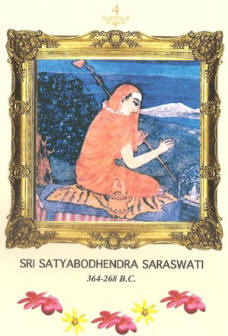
|
Sri Sathyabodhendra Saraswati : He is a native of Amaravatitheera in Chera country, and was known as Phalinisa in his poorvasrama. He was the son of one Thalinesa Sharma. He was a great fighter of Samkhyas, Bauddhas and Jainas. He was the author of Padaka-Sata (explanatory treatise on Sankara Bhashya). Sri Sathyabodhendra Saraswati attained mukti at Kanchi on Krishna astami in the month of Vaishaka of the cyclic year Nandana (268 BCE ). |
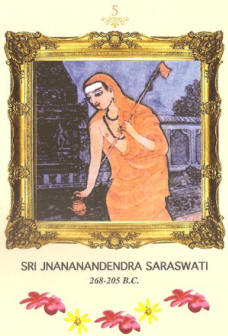
|
Sri Jnanandendra Saraswati : He was known as Jnanottama before Sanyasa. He was the son of Nagesa, a Dravida Brahman. He was a great tarkika and wrote a commentary called Chandrika, on Sri Sureswaracharya's Naishkarmya Siddhi. He, in his Chandrika commentary, has spoken of his guru Sri Satyabodha and Parama Guru Sri Sarvajnatman. This Chandrika commentary was edited and published by Prof. Hiranayya of the Mysore University. In the preface to this commentary, Sri Jnaanandendra Saraswati has spoken of himself as the glory of the Sarvajasrama at Kanchi. He attained mukti at Kanchi on Sukla Saptami in the month of Mrigaseersha of the cyclic year Manmatha (205 BCE). |

|
Sri Suddhanandendra Saraswati : He was the son of Bharvu Pandita and a native of Vedaranyam. His former name was Viswanatha. He was a Dravida Brahmin. Sri Suddhanandendra Saraswati attained mukti at Kanchi on Sukla Shashti in the month of Jyestha of the cyclic year Nala (124 BCE). |
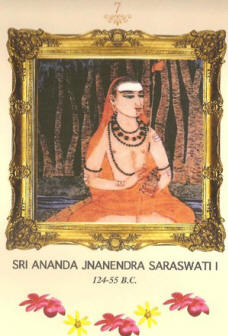
|
Sri Aanandaghanendra Saraswati : He was known as Chinnayya before Sanyasa. He was the son of Suryanarayana Makhi. He hailed from Chera country. A great votary of Gauri, through divine grace of God, he obtained extraordinary literary powers. He wrote commentaries on the Sankara Bhashyas and Sureswaracharya's Vartikas. He attained mukti at Srisail on KrishnaNavami in the month of Vaisakha of the cyclic year Krodhana (55 BCE). |

|
Sri Kaivalyanandayogendra Saraswati : Before Sanyasa, he was known as Manganna and a native of Tirupati in Andhra. He was the son of Trailinga Sivayya , He attained mukti at Kanchi on first day of Makara of the, cyclic year Sarvadhari (28 CE), |
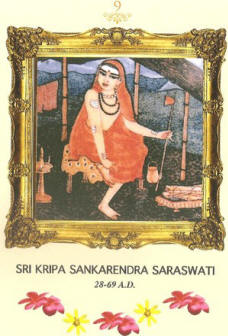
|
Sri Krpa Sankarendra Saraswati : An Andhra Brahmin by birth, his former name was Gangesopadyaya. He devoted himself, heart and soul, to the eradication of degenerate, obscene practices that had once again crept into religion after the Bhagavatpada's time, and restored purity. It fell to the lot of Krpa Sankara to continue and perfect the noble work that Sri Adi Sankara had inaugurated. Krpa Sankara pursued with great vigour, the work of the Master and enhanced the greatness of Shanmatas introducing a chastened mode of worshiping Siva, Vishnu, Ambika, Surya, Ganapati and Skanda. In short, he prepared the ground for the growth of the devotional path to be attempted in the future by Saiva Nayanars, These later Saiva and Vaishnava religious reformers owe it to both Adi Sankara and Krpa Sankara so that their work was rendered easier by the preliminary religious reforms effected by the two great luminaries. He is said to have attained mukti at a place near Vindhya region on Krishna Tritiya in the month of Kartika of the cyclic year Vibhava (69 CE). |

|
Sri Sureswara: Who succeeded Sri Krpa Sankara was a Maharashtra Brahmin and his poorvasrama name was Maheswara. He was the son of Iswara Pandita. He attained mukti at Kanchi on Purnima in the month of Ashada of the cyclic year Akshaya (127 CE). |

|
Sri Sivananda Chidghanendra Saraswati : He was a Karnataka Brahmin and the son of one Ujjvala Bhatta. His poorvasrama name was Iswara Vatu. His predilections were towards Sivaadvaita. He attained mukti at Vrjddhachala on Sukla Dasami in the month of Jyestha of the cyclic year Virodhikrit (172 CE). |

|
Sri Chandrasekharendra Saraswati : He was a native of a village near River Palar and was the son of Vatsa Bhatta. His former name was Hari. He entrusted the affairs of the Matha in the hands of one of his sishyas and engaged himself in a special type of Yoga. After a reign of sixty-three years, he disappeared into a cave in Seshachala on Sukla Navami in the month of Ashada of the cyclic year Ananda (235 CE). |

|
Sri Satchidghanendra Saraswati : Known as Seshaya in his poorvasrama, he belonged to a village on the bank of the Gadilam river. He was the son of Sridhar Pandlta. Like his predecessor, he relinquished his pontificate to his successor and wandered about the environs of Kanchi as an "Avadhuta". After wandering for over thirty-two years, he disappeared into a. temple in Kanchi and it is said that his mortal frame got transformed into a Linga, now identified with Kayarohaneswara at Kanchi on Sukla Prathama in the month of Margasirsha of thecyclic the cyclic year Khara (272 CE). |

|
Sri Vidyaghanendra Saraswati : He was Andhra by birth. His name before Sanyasa was Nayanai A great adept in Mantra Sastra, He is said to have mollified Ugra Bhairava. He attained mukti at a place near Agastya Hill on Amavasya in the month of Margasirsha d the cyclic year Dhatu (317 CE) |
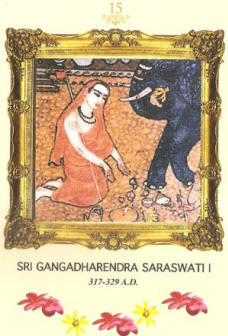
|
Sri Gangadharendra Saraswati : Hailing from Andhra, he was the son of Bhadragiri of Kanchi. His former name was Subhadra. Gangadhara was renowned for his great erudition. He attained mukti near the Agastyq Hill on Sukla Prathama in the month of Chaitra of the cyclic year Sarvadhari (329 CE). |
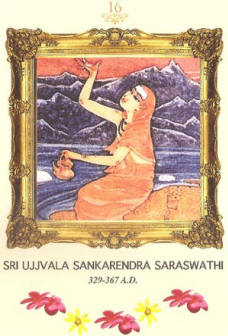
|
Sri Ujjvala Sankarendra Saraswati : Before Sanyasa, he was known as Achyuta Kesava. He was son of Kesava Sankara. He was a Maharasthra Brahmin by birth. He was a great fighter of heretics. He went on Digvijaya and during his tours he drove the followers of Jainism beyond the Sindhu. He visited Kashmir and attained mukti at Kalapuri. Since then the place came to be known as Ujjvala Maha Yatipura on Sukla Ashtamj in the month of Valsakha of the cyclic year Akshaya (367 CE). |
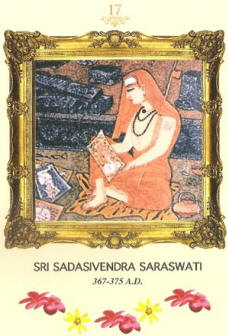
|
Sri Sadasivendra Saraswati : He was the son of Deva Misra, a Brahmana Minister of Kashmir. He showed a leaning towards Vedanta in his early years. He was ordained in Sanyasa by Sri Ujjvala Sankara. Wherever he went, he fed a number of Brahmanas every day. He attained mukti at Tryambaka (near Nasik) on Sukla Dasami in the month of Jyestha of the cyclic year Bhava (375 CE). |

|
Sri Yogafilaka Surendra Saraswati : He was a native of Maharasahtra and the son of one Madhava. He vanquished the notorious Charwivaka Durdivi by argument. He attained mukti near Ujjain on Sukla Prathama in the month of Margasirsha of the cyclic year Taruna (385 CE). |
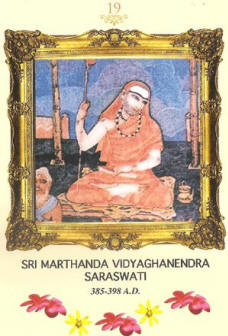
|
Sri Martanda Vidyaghanendra Saraswati : Also known as Suryadasa, he was the son of one Umesa Sankara, His former name was Srikanta. Early in life, he was afflicted by Leuco-derma. But he got completely cured of the disease by offering 1008 prostrations to Bhagavan Surya every day. He was ordained in his eighteenth year and after a reign of 13 years, he attained mukti at a village on the bank of the Godavari on Krishna Navami in the month of Bhadrapada of the cyclic year Hevilambi (398 CE). |

|
Sri Muka Sankarendra Saraswati : He was the son of one Vidyavati, an astrologer and astronomer. He was a congenital deaf-mute. But through the grace of Goddess Kamakshi he gained the power of speech. On knowing this attainment of speech by Mooka because of the grace of Devi, the then Acharya of Sri Kanchi Kamakoti Peetam, Sri Vidyaghana, sent for the boy's parents and told them of his intention of giving sanyasa to the boy and, with their consent, gave sanyasa to the boy and ordained him as his successor in the Kamakoti Math. Vikramaditya Sakari of Ujjain, Matrugupta, some time king of Kashmir, and Pravarasena, who succeeded Matrugupta on the throne, all considered it a rare privilege to serve at the feet of this great Acharya. Muka Sankara is the author of Muka Panchasati, a lyrical outburst of poetry on Kamakshi, The mellifluence of the work is said to be rivaled only by Lila Suka's Krishna Karnamrta. He attained mukti at a village near Godavari on full moon day in the month of Sravana of the cyclic year Dhatu (437 CE). |

|
Sri Chandrasekharendra Saraswati II : He was a native of Konkan and the son of Achyuta. He succeeded Muka Sankara as the Pontiff of the Kamakoti Peetha and attained mukti at Banares on Krishna Astami in the month of Sravana of the cyclic year Vyaya (447 CE). |

|
Sri Bodhendra Saraswati : He was the son of one Ramanatha, a native of Ratnagiri in Maharashtra. His name prior to sanyasa was Madhura. He was a great physician and yogi. He attained mukti near Jagannatha Kshetra on Sukla Navami in the month of Kartika of the cyclic year Raudri (481 CE). |
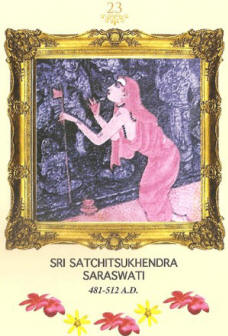
|
Sri Satchisukhendra Saraswati : He was a native of Srikakulam in Andhra and son of Somanarayan. His former name was Girisa. He was a great votary of Subramanya. He attained mukti near Jagannatha Kshetra on Sukla Saptami in the month of Vaisaka of the cyclic year Khara (512 CE). |
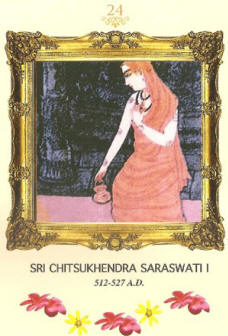
|
Sri Chitsukhendra Saraswati : He was a native of Konkan and was known as Siva Sarma before sanyasa. All through his pontificate, he remained in Konkan and attained mukti near Ratnagiri on Bahula Navami in the month of Sravana of the cyclic year Prabhava (527 CE). |

|
Sri Satchidanandaghanendra Saraswati : He was the son of Krishna, a native of Srimushnam. He was a Dravida Brahrnana. Thrice he toured extensively all over India. He Was a great Yogi, and by his yogic powers, he is said to have turned Into a Linga at Gokarna on Sukla prathama in the month of Ashada of the cyclic year Prabhava (548 CE). |

|
Sri Prajnaghanendra Saraswati : .He was the son of Prabhakara, a native of a village on the bank of the Pinakini. His former name was Sonagiri. He attained mukti at Kanchi , on Sukla Ashtami in the month of Vaishaka of the cyclic year Svabhanu (546 CE). |
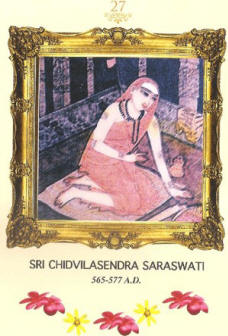
|
Sri Chidvilasendra Saraswati : He was the son of Madhusudhana, a native of Hastagiri. His former name was Hari Kesava and he was an Andhra by nationality. He attained mukti at Kanchi on the First day in the month of Chaithra of the cyclic year Durmukhi (577 CE). |
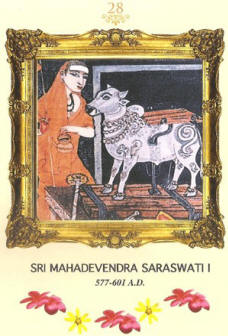
|
Sri Mahadevendra Saraswati I : He was the son of Bhanu Misra, a native of Bhadrachala. His pre- sanyasa name was Sesanarayana. He was a Maithila Brahmana domiciled in Andhradesa. He attained mukti at Kanchi on Krishna Dasami in the month of Asvina of the cyclic year Raudri (601 CE). |

|
Sri Purnabhodhendra Saraswati : He was the son of Sripati. His former name was Krishna. He attained mukti at Kanchi on Sukla Ekadasi in the month of Sravana of the cyclic year Eswara (618 CE) |

|
Sri Bhodhendra Saraswati II: He was the son of one Kajahasti. His Poorvasrama name was Balayya. He attained mukti at Kanchi on Krishna Chaturti in the month of Vaisaka of the cyclic year Ananda (655 CE). |

|
Sri Brahmanandaghanendra Saraswati : He was the son of one Ananta, a native of a village on the bank of the river Gadilam. A Dravida Brahmana by birth, his former name was Jyestha Rudra. He was an authority in the six Darsanas. He was held in high veneration by King Lalitadiya Muktapida of Kashmir and by the great dramatist Bhavabhuti. He attained mukti at Kanchi on Sukla Dwadasi in the month of Jyeshta of the cyclic year Prabhava (668 CE). |
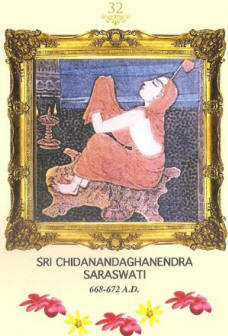
|
Sri Chidanandaghanendra Saraswati : He was the son of one Kanva Sankara. His former name was Padmanabha. He was a great yogi and he subsisted on dry leaves only. He attained mukti at Kanchi on Sukla Shashti in the month of Margasirsha of the cyclic year Prajotpatti (672 CE). |

|
Sri Satchidananda Saraswati : Otherwise known as Bhaskara Paramesthi. He was the son of one Praudha Ramanna, a native of a village on the bank of the Chandrabhaga. His former name was Timmanna, and he was a versatile linguist. He carried out extensive repairs to the Math buildings at Kanchi and attained mukti on Krishna Shashti in the month of Prostapada of the cyclic year Khara (692 CE). |
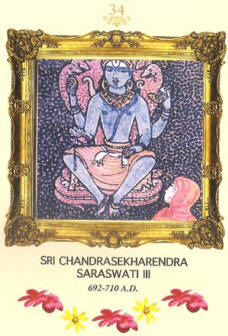
|
Sri Chandrasekharendra Saraswati III : was the son of Mahadeva, a native of a village adjoining the river Vegavati. His former name was Sambhu and he made extensive tours. On one occasion, he heroically saved a child that had been caught in the midst of wild fire in a forest. He attained mukti at Kanchi on New Moon day in the month of Margasirsha of the cyclic year Saumya (710 CE). |

|
Sri Chitsukhendra Saraswati : He was the son of Vimalaksha, a native of Vedachala. His pre-sanyas name was Susila Kamalaksha. He attained mukti in the Sahya mountain area on Sukla Shashti in the month Ashada of the cyclic year Dhatu (737 CE). |

|
Sri Chitsukhanandendra Saraswati : He was the son of Somagiri, a native of a village adjoining Palar. He was a Dravida by nationality and his former name was Suresa. He attained mukti at Kanchi on Purnima in the month of Asvina of the cyclic year Hevilambi (758 CE). |

|
Sri Vidyaghanendra Saraswati III: He was the son of Balachandra. His former name was Suryanarayana. He attained mukti at Chidambaram, where he had gone on a pilgrimage on Krishna Dwitiya in the month of Pushya of the cyclic year Prabhava (795 CE). |
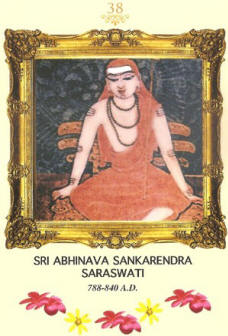
|
Sri Abhinava Sankarendra Saraswati : He was one of the greatest among the successors of Adi Sankara, so great indeed that he and his deeds are often confounded with those of the Great Bhagavatpada and his deeds. His life story has been described in detail in a work entitled the "Sankara Vilasa" by Vakpati Bhatta. His father was one Visvajit of Chindambaram. He was invested with Yajnopavita at the age of five and taught Vedas. He showed an extraordinary promise in dialectics and soon he became a formidable disputant on intricate questions in philosophy. He defeated Vakpati Bhatta, a great scholar of that time, in argument. He ascended the Savajna Pitha in Kashmir. It is said that he entered the Dattatreya cave in the Atreya Mountains in the Himalayas on Amavasya in the month of Ashada of the cyclic year Slddharti (840 CE) and that it was the end of his mortal career. |
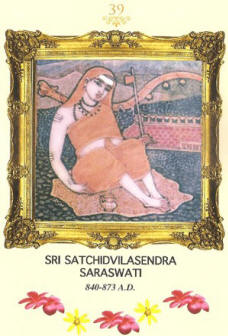
|
Sri Satchidvilaasendra Saraswati : He was the son of Kamaleswara of Kanyakubja and was known by the name Sripati before Sanyasa. For a long time, He lived in Padmapura. He attained mukti at Kanchi on Purnima in the month of Vaishaka of the cyclic year Nandana (873 CE). |

|
Sri Mahadevendra Saraswati II: He was the son of one Kannayya, a native of Karnataka. His poorvasrama name was Sivaramabhatta. He was of a very handsome appearance and hence styled Sobhana and Ujjvala. He attained mukti at Kanchi on Sukla Shashti in the month of Vaisakha of the cyclic year Bhava (915 CE). |
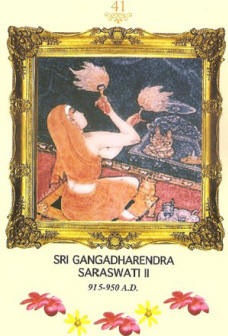
|
Sri Gangadharendra Saraswati II: He was the successor of Sri Mahadevendra and he was the son of Umesabhatta, a native of a village on the bank of the Bhima river. His former name was Appanna, and he was a Karnataka by nationality. He is said to have restored vision to the poet Rajasekhara, who had become blind, He attained mukti at Kanchi on Sukla Prathama in the month of Sravana of the cyclic year Saumya (950 CE). |

|
Sri Brahmanandaghanendra Saraswati : He was the son of one Subramanya. He was known by the name Narasambhatta prior to sanyasa. He attained mukti at Kanchi on Sukla Prathama in the month of Sravana of the cyclic year Eswara (978 CE). |
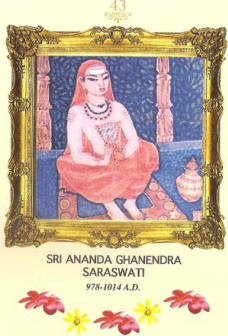
|
Sri Anandaghanendra Saraswati : He was the son of Sudeva Bhatta, a native of a village in the Tungabhadra valley. His name before initiation into the ascetic order was Sankara Pandita. He attained external bliss at Kanchi on Sukla Navami in the month of Chaitra of the cyclic year Pramadi (1014 CE). |

|
Sri Purnabhodhendra Saraswati II : His father was Siva, native of Karnataka region. His name in the former ashrama was Hari. He attained videha mukti at Kanchi on Krishna Trayodasi in the month of Proshtapada of the cyclic year Pramadi (1040 CE). |

|
Sri Paramasivendra Saraswati I: He was the son of Sivasamba Panditar. His name before he became an ascetic was Srikanta. He attained mukti at Kanchi on Sukla Saptami in the month of Asvina of the cyclic year Sarvari (1061 CE). |

|
Sri Sandranandabhodhendra Saraswati : He was the son of Surya. His former name was Somadeva and he spent a great part of his early life in attending on his Guru and predecessor Paramasiva I. He was the author of Katha-Sarit Sagara. He was presented with a palanquin wrought with pearls by King Bhoja of Dhara. He attained mukti at Arunachala Kshetra on Arriavasya in the month of Ashada of the cyclic year Esvara (1098 CE). |
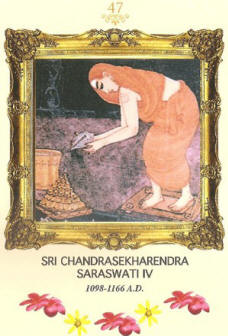
|
Sri Chandrasekharendra Saraswati IV: otherwise known as Chandrachuda. He was the son of Suka Deva, a native of Kundini riverside. He was a Dravida by nationality and his pre-sanyasa name was Srikantha. He went on tours of digvijaya and defeated in argument Hemacharya, a great Jain teacher in the court of Vidyalola Kumarapala, and author of Kumarapala Charita. This Acharya was also held in considerable veneration by Mankha, the author of Srikantha Charita,by Krishna Misra, the author of Prabhoda Chadrodaya and Guruvijaya and Jayadeva, author of Prasanna Raghavan, Chandraloka and Bhakti Kalpa Latika, and Suhala, and also by a physician of Kashmir and author of a medical lexicon, known as Vaidyabhidhana Chintamani, Jayadeva has celebrated the victory of Chandrasekhara over Hemacharya in his Bhakti Kalpalatika. Jayasimha, king of Kashmir, considered himself blessed in the service of this great Acharya. He attained mukti at Arunachala Kshetra on Amavasya in the month of Chaitra of the cyclic year Parthiva (1166 CE). |
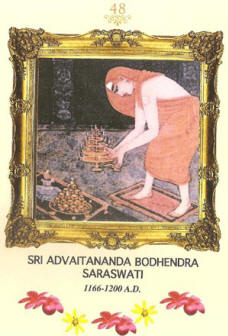
|
Sri Advaitanandabodhendra Saraswati : Also called Chidvilasa. He was the son of Premesa, who was a native of a village on the bank of the Pinakini. His poorvasrama name was Sitapati. He defeated in argument Sriharsha, author of Khandana Khanda Khadya and Naishada, as also Abhinava Gupta, a tantrik writer. He was the author of Brahmavidyabharana, Santi Vivarana and Gurupradipa. He attained mukti at Chidambaram on Sukla Dasami in the month of Jyeshta of the cyclic year Sidharthi (1200 CE). |
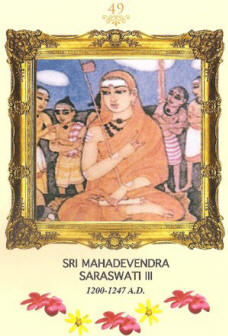
|
Sri Mahadevendra Saraswati III : He was the son of Achyuta of Chhayavanam in the Tanjore District. His former name was Gurumurthi. He was a devout worshipper of Parasakti but not a tantrika. He attained mukti on the banks of the Gadilam River on Krishna Ashtami in the month of Sravana of the cyclic year Parabhava (1247 CE). |
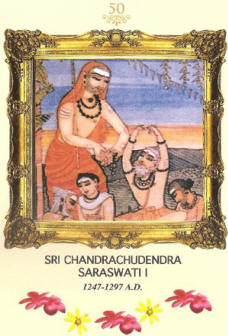
|
Sri Chandrachudendra Saraswati I: He was the son of Arunagiri and was known as Gangesa before sanyasa. Like his Guru Mahadeva, he was also an ardent devotee of Parasakti and offered one crore of oblations in a homa performed to propitiate Paradevata. He attained mukti on the banks of the Gadilam river on Sukla Shashti in the month of Jyesta of the cyclic year Durmukhi (1297 CE). |
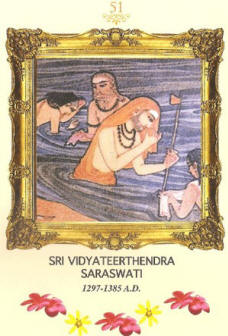
|
Sri Vidyateerthendra Saraswati : He was the son of one Sarangapani, a native of Bilvaranya. His pre-sanyasa name was Sarvajna Vishnu. Sayana, commentator of the Vedas, Madhava (later Vidyaranyaswami), Vedanta Desika, the Vaisnava scholar, and Bharati Krisna Tirtha, were all pupils of Vidya Tirtha. After reigning at the Kanchi Math for 73 years, he went to the Himalayas to perform tapas. After spending 15 years in tapas, he attained videha mukti there on Sukla Prathama in the month of Magha of the cyclic year Raktakshi (1385 CE). |

|
Sri Sankaranandendra Saraswati : He was the son of Balachandra, a native of Madhyarjuna or Tiruvidaimarudur. His former name was Mahesa. Before succeeding to the pontifical throne, he had accompanied Vidya Tirtha to the Himalayas. It was Sankarananda who was largely instrumental in the founding of eight new Advaita Mathas in Karnataka. He was the author of Dipikas on Isa, Kena, Prasna and Brhadaranyaka Upanishads. He was the author of Atma Purana and a commentary on the Bhagavat Gita. He vigorously combated the aggressive propaganda carried on by Vaisnava and Madwa sectarians. He attained mukti at Kanchi on Sukla Prathama in the month of Vaisakha of the cyclic year Durmukhi (1417 CE). |
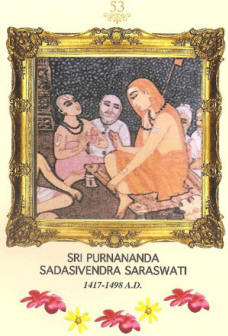
|
Sri Purnananda Sadasivendra Saraswati: He was a native of Nagaranya. He was the son of one Naganatha. He went on a tour to Nepal and was accorded royal honours by the King of Nepal. He attained mukti at Kanchi on Sukla Dasami in the month of Jyesta of the cyclic year Pingala (1498 C.E). |

|
Sri Vyasachala Mahadevendra Saraswati : He was the son of Kamesvara and Kamalamba who belonged to Kanchi. His pre-sanyasa name was Kuppanna. He is the author of a Sankara Vijaya. He attained mukti at Vyasachala on the first day of the cark fortnight of Ashada in the cyclic year Akshaya (1507 CE). |
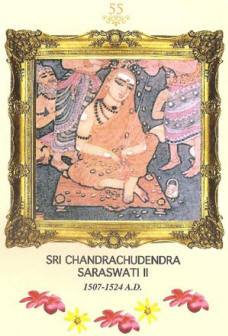
|
Sri Chandrachudhendra Saraswati II : He was a native of Asmachala, near Manimuktar river in South Arcot District. He was the son of Purari and Srimati. His former name was Arunagiri. He was a Dravida Brahmana. He attained mukti at Kanchi on Sukla Ekadasi in the month of Meena of the cyclic year Swabhanu (1524 CE). |

|
Sri Sarvajna Sadasiva Bhodhendra Saraswati : He was the son of Chiruta Chikkanna, a native of a village on the banks of the north Pennar. He was the Guru of Pravira Setupati Raja of Ramnad. It is said that he was the author of Svatma Nirupana. He attained mukti at Rameswaram on Sukla Ashtami in the month of Chaitra of the cyclic year Vilambi (1539 CE). |

|
Sri Paramasivendra Saraswati II : He was the son of Parameswara, native of a village on the bank of the river Pampa. He was known as Sivaramakrishna before Sanyasa. He was the Guru of the great Sadasiva Brahmendra, the author of the Gururatna malika and the great Brahma Jnani. The greatness of Paramasivendra may be gauged from the fact that Sadasiva Brahmendra used to carry the sandals of the Acharya always on his head. And the greatness of Sadasiva Brahmendra may also be understood by an incident, which is recounted in popular tradition, Sadasiva steeped in the bliss of Brahman, was wandering about as an Avadhuta, to all appearances like a mad man. Some one reported to Paramasivendra that Sadasiva had gone mad. The Acharya is reported to have answered "I wish I had but a touch of that madness". So great indeed was Paramasivendra that Sadasiva Brahmendra has immortalised immortalised him in his Atma Vjdya Vilasa. This Acharya wrote a commentary on Siva Gita. He attained mukti at Svetaranya (Tiruvenkadu) in Tanjore District on Sukla Dasami in the month of Sravana of the cyclic year Parthiva (1586 CE). |
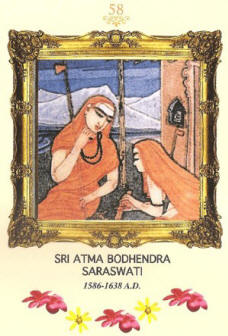
|
Sri Atma Bodhendra Saraswati : He was a native of Vruddhachala, and son of one Viswamakhi. His pre-sanyasa name was Visvesvara. He toured extensively and stayed at Benares for a long time. He wrote a Bhasya on the Sri Rudram. It was Atma Bodha that directed Sadasiva Brahmendra to write the Gururatna Malika. He attained mukti on the banks of the river South Pinakini, known in Tamil as Then Pennai on Krishna Ashtami in the month of Tula of the cyclic year Eswara (1638 CE). |

|
Sri Bhagavannama Bodhendra Saraswati :
He was born in Mandana
Misra Agraharam at Kanchi as the son of one Kesava Panduranga.
Bhoddendra's former name was Purushottama. It was he who stressed
the efficacy of devotion as a means to liberation in Kali. He
therefore undertook the great task of Nama Siddhanta, or
establishing the supreme efficacy of reciting the names of Bhagavan
in many of his writings, chiefly in Namamrta Rasayana and Namamrta
Rasodaya. His mission of Nama Siddhanta was pursued with equal vigor
by Sridhara Venkatesa, or Ayyaval of Tiruvisainallur and by Sadguru
Swami of Marudanallur. It was the Nama Siddhanta of Bodhendra that
was ultimately responsible for the evolution of Bhajana Sampradaya
as an institution in the religious life of the Hindu community in
South India. |
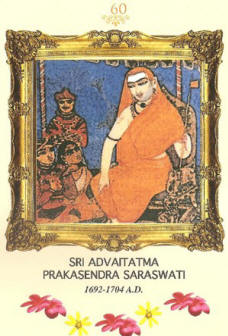
|
Sri Advaitatma Prakasendra Saraswati : He was also known as Govinda. He was the son of Parasurama, a native of a village adjoining the river Vasistha. His former name was Sruti-Pandita. For some time, he lived in Govindapuram where his predecessor had attained mukti. He was held in very great veneration by Sahaji, , the King of Tanjore. He attained mukti at the village Ambi, near Kanchi on Krishna Dwitiya in the month of Chaitra of the cyclic year Svabhanu (1704 CE). His brindavan at Ambi is in daily worship. |

|
Sri Mahadevendra Saraswati IV: He was previously known as Narayana. He was a great yogi. It was during his pontificate that Atma Bodha wrote his commentary Susama on the Gururatna Malika. He attained mukti at Tiruvottiyur, now a part of Chehnai on Sukla Navami in the month of Jyesta of the cyclic year Krothana (1746 CE). |

|
Sri ChandrasekharendraSaraswati V: Kanchi was involved in the Karnatic wars and peaceful existence there had become impossible. Hence the Acharyas of Kamakoti Peetha decided on migrating south though Kanchi still figured as the nominal headquarters. The golden image of Kamakshi (Bangaru Kamakshi) had already been carried away by the sthanikas of the temple first to Udayarpalayam, and later to Tanjore where it has been permanently installed. The Acharya Chandrasekhara himself acceded to the request of Pratapa Simha, Rajah of Tanjore (1740-63) and took up his permanent headquarters at Tanjore. But Kumbakonam, on the banks of the sacred river Kaveri, was found more suitable and shortly thereafter the Acharya shifted to Kumbakonam. Chandrasekhara attained mukti at Kumbakonam on Sukla Prathama in the month of Pushya of the cyclic year Subhakrt (1783 CE) |
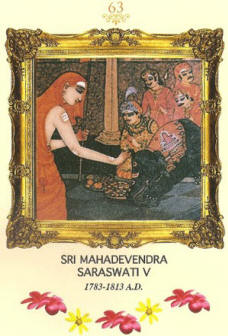
|
Sri Mahadevendra Saraswati V: He was a great yogi. His former name was Anna Srauti. He was a native of Kumbakonam. He attained mukti at Kumbakonam on Sukla Dwadasi in the month of Ashada of the cyclic year Srimukha (1813 CE). |
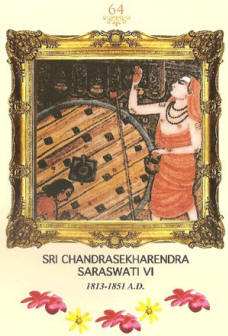
|
Sri Chandrasekharendra Saraswati VI: He was known as Venkatasubramanya Dikshita prior to his sanyasa and belonged to the talented family of the great Govinda Dikshita, the Brahmana minister of Tanjore, who is still lovingly remembered as "Ayyan". He was a great adept in Mantra Sastra. The Acharya caused repairs to the temple of Sri Kamakshi at Kanchi and performed kumbhabhishekham on 22nd January 1840 AD. He got the tatankas (ear-oranaments) of Devi Akilandesvari in the Tiruvanaikoil and re-consecrated them on the ear of the goddess in 1848 CE. He attained mukti at Kumbakonam on Sukla Prathama in the month of Karthika of the cyclic year Sadarana (1851 CE). |

|
Sri Sudarsana Mahadevendra Saraswati : Son of Seshadri Sastri of Madhyarjuna was known as Mahalingam prior to his sanyasa. He toured extensively and attained siddhi at Ilaiyattangudi on Amavasya in the month of Phalguna of the cyclic year Virodhi (1891 CE). A Temple has been built by the Nattukottai Chettiars on his samadhi. |

|
Sri Chandrasekharendra Saraswati VII : He was the son of Sitarama Sastri. This Acharya's poorvasrama name was Swaminatha. He was a native of Udayambakkam. He attained mukti at Kalavai in the year 1907 on Krishna Ashtami in the month of Magha of the cyclic year Parabhava (1907 CE). |

|
Sri Mahadevendra Saraswati V: He was the son of Narasimha Sastri and Lakshmi and was known as Lakshmi Narasimha prior to sanyasa. He occupied the Peetha for seven days only and attained mukti at Kalavai on Sukla Prathama in the month of Phalguna of the cyclic year Parabhava (1907 CE). |
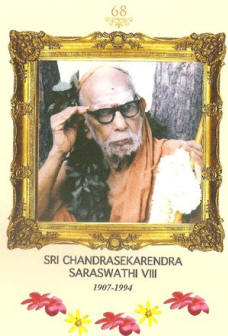
|
The 68th Pontiff His Holiness Sri Chandrasekharendra
Saraswati Swamigal |
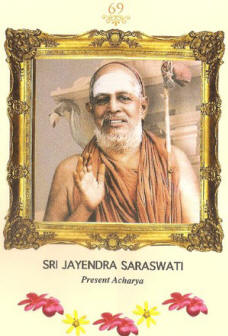
|
The 69th Pontiff His Holiness Sri Jayendra Saraswati
Swamigal
|
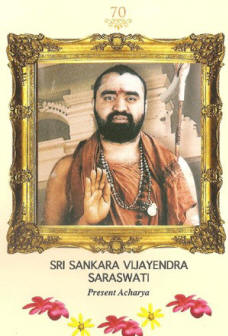
|
The 7Oth Shankaracharya His Holiness Sri Sankara Vijayendra
Saraswati Swamigal |
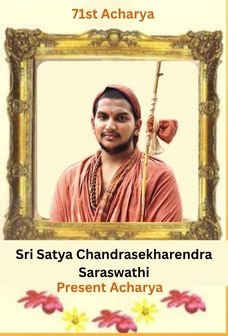
|
The 71st Shankaracharya His Holiness Sri Satya Chandrasekharendra Saraswathi Swamigal |